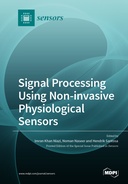Explore

Signal Processing Using Non-invasive Physiological Sensors
0 Ungluers have
Faved this Work
Login to Fave
Non-invasive biomedical sensors for monitoring physiological parameters from the human body for potential future therapies and healthcare solutions. Today, a critical factor in providing a cost-effective healthcare system is improving patients' quality of life and mobility, which can be achieved by developing non-invasive sensor systems, which can then be deployed in point of care, used at home or integrated into wearable devices for long-term data collection. Another factor that plays an integral part in a cost-effective healthcare system is the signal processing of the data recorded with non-invasive biomedical sensors. In this book, we aimed to attract researchers who are interested in the application of signal processing methods to different biomedical signals, such as an electroencephalogram (EEG), electromyogram (EMG), functional near-infrared spectroscopy (fNIRS), electrocardiogram (ECG), galvanic skin response, pulse oximetry, photoplethysmogram (PPG), etc. We encouraged new signal processing methods or the use of existing signal processing methods for its novel application in physiological signals to help healthcare providers make better decisions.
This book is included in DOAB.
Why read this book? Have your say.
You must be logged in to comment.
Rights Information
Are you the author or publisher of this work? If so, you can claim it as yours by registering as an Unglue.it rights holder.Downloads
This work has been downloaded 166 times via unglue.it ebook links.
- 166 - pdf (CC BY) at Unglue.it.
Keywords
- Acoustic
- AMR voice
- auscultation sites
- Biomedical Signal Processing
- blink
- Brain-computer interface
- brain–computer interface
- channel of interest
- channel selection
- Classification
- Computer Aided Diagnosis
- Congenital heart disease
- Convolution Neural Network (CNN)
- convolutional neural network (CNN)
- deep neural network
- discrete wavelet transform
- ECG
- ECG derived respiration (EDR)
- EEG
- electrocardiogram (ECG)
- electroencephalogram (EEG)
- Electroencephalography
- EMG
- emotion recognition
- empirical mode decomposition
- eye blink
- feature extraction
- feature selection and reduction
- functional near-infrared spectroscopy
- GSR
- Home automation
- human machine interface (HMI)
- hybrid brain-computer interface (BCI)
- Hypertension
- image gradient
- Image processing
- Long Short-Term Memory (LSTM)
- Machine learning
- Medical equipment & techniques
- medicine
- Medicine: General Issues
- mel-frequency cepstral coefficients
- mental imagery
- mobile
- Motor Imagery
- movement intention
- movement-related cortical potential
- multiscale principal component analysis
- myoelectric control
- Neurorehabilitation
- Open-CV
- pattern recognition
- phonocardiogram
- physiological signals
- pulse plethysmograph
- quadriplegia
- Raspberry Pi
- reaction
- reflex
- region of interest
- Rehabilitation
- respiratory rate (RR)
- Response
- short-time Fourier transform (STFT)
- Sound
- startle
- statistical analysis
- steady-state visually evoked potential (SSVEP)
- Stroke
- successive decomposition index
- support vector machines
- thema EDItEUR::M Medicine and Nursing::MB Medicine: general issues::MBG Medical equipment and techniques
- Wheelchair
- z-score method
Links
DOI: 10.3390/books978-3-0365-3719-1Editions

